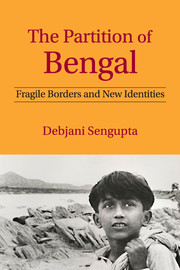Book contents
- Frontmatter
- Dedication
- Contents
- Acknowledgements
- Introduction
- 1 The Calcutta Riots in Representations and Testimonies
- 2 Noakhali and After: History, Memory and Representations
- 3 Colony Fiction: Displacement and Belonging in Post-Partition Bangla Fiction
- 4 From Dandakaranya to Marichjhapi: Refugee Rehabilitation in Bangla Partition Fictions
- 5 The Partition's Afterlife: Nation and Narration from the Northeast of India and Bangladesh
- 6 Uncanny Landscapes and Unstable Borders: Politics and Identity in Geo-Narratives of the Partition (2005–10)
- Bibliography
- Index
4 - From Dandakaranya to Marichjhapi: Refugee Rehabilitation in Bangla Partition Fictions
Published online by Cambridge University Press: 18 December 2015
- Frontmatter
- Dedication
- Contents
- Acknowledgements
- Introduction
- 1 The Calcutta Riots in Representations and Testimonies
- 2 Noakhali and After: History, Memory and Representations
- 3 Colony Fiction: Displacement and Belonging in Post-Partition Bangla Fiction
- 4 From Dandakaranya to Marichjhapi: Refugee Rehabilitation in Bangla Partition Fictions
- 5 The Partition's Afterlife: Nation and Narration from the Northeast of India and Bangladesh
- 6 Uncanny Landscapes and Unstable Borders: Politics and Identity in Geo-Narratives of the Partition (2005–10)
- Bibliography
- Index
Summary
They come to this door: Go away!
They go there: Shoo them away!
Oh queen, oh my queen,
All over your kingdom,
The doomed children
Of menial mothers
Arrive in a swarm.
Oh the shame! The shame!
Subhash Mukhopadhyay, Thakurmar JhuliI
When India's partition took place in 1947 East Bengal had a sizeable Hindu population. In the first few months about 344,000 refugees came into West Bengal, many of them middle class people who had jobs in West Bengal or some family connections to sustain them. Here, there was no equal exchange of population as in Punjab because many believed that the partition was a temporary affair. However, in the months that followed increasing communal tensions in East Pakistan resulted in a steady arrival of Hindus in West Bengal while some Muslims decided either to leave or to relocate in safer localities where there was a substantial population of co-religionists, especially in the border areas. With every successive migration, there was, therefore, a massive population pressure on the state. To prevent further influx of refugees in the months after the country was divided, a number of government initiatives were undertaken to see that the minorities in East Pakistan remained where they were. In April 1948, an Inter-Dominion conference was held in Calcutta where the Rehabilitation Ministers of West Bengal and Pakistan declared their intention to take possible steps to prevent an exodus. It was decided to establish Minority Boards at the provincial and local levels in both countries to redress grievances and as a confidence building measure. Another Inter-Dominion conference took place in December 1948 to follow up on these actions.
These measures, however, largely failed to stem the waves of refugees coming into West Bengal. Although their decision to leave was based on a set of complex calculations, a number of reasons, economic and political, made the Hindus apprehensive about living on in East Pakistan. A spokesman of the East Bengal Minority Committee claimed that nearly 2.5 lakh members of minority communities had already left for the Indian Union (Hindustan Standard, 28 March 1948) amidst growing allegations of atrocities on Hindu villagers in various districts like Sylhet (Amrita Bazar Patrika,20 November 1949).
- Type
- Chapter
- Information
- The Partition of BengalFragile Borders and New Identities, pp. 157 - 187Publisher: Cambridge University PressPrint publication year: 2015



